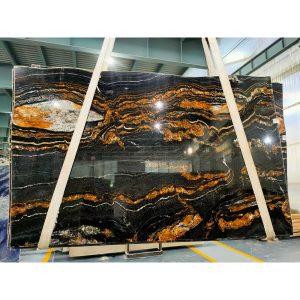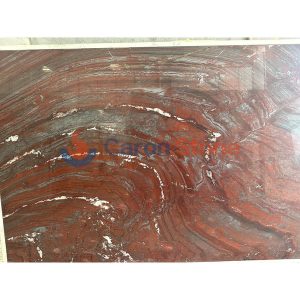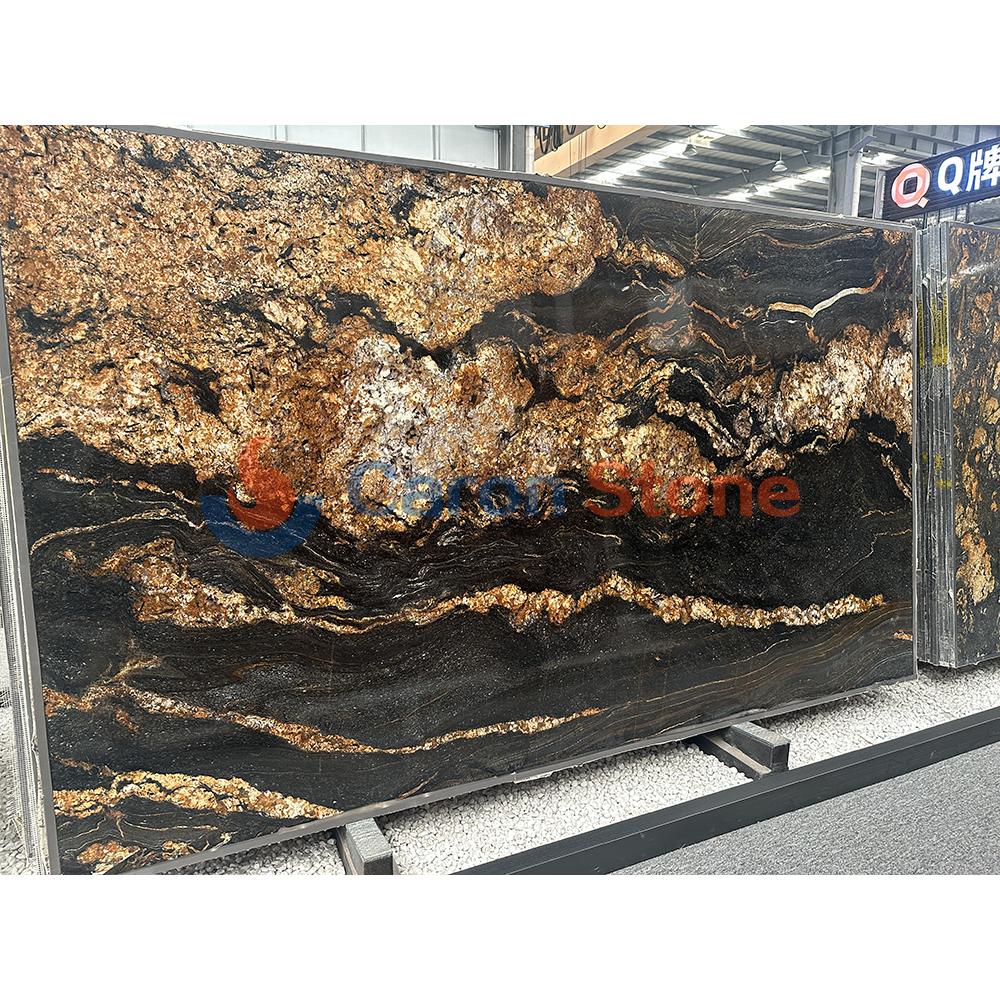Granite, a hard stone that can be found everywhere in our daily lives, is not only a common visitor in building materials, but also a gift from nature. Granite draws people’s attention with its distinctive texture and durability whether it is on kitchen counters at home or in great skyscrapers. But have you ever thought how a smooth granite piece was created? You enjoy it now. In the process of millions or even billions of years of geological evolution, granite was slowly and mysteriously born from the depths of the earth, experiencing extreme temperatures and pressures, and finally became the magnificent stone we see today. From the molten lava inside the earth to the cooled and hardened rock, this article will transport you to investigate the formation process of granite, so revealing the secret of this natural beauty.

Matrix Titanium Granite slab
The inner core of the earth: the cradle of granite
To understand the formation of granite, you first need to understand the structure of the earth. The crust, the mantle, and the core define three divisions of the earth. Granite hails from the earth’s crust. About 5 to 70 kilometers thick, the crust is the solid outermost section of the earth. The mantle of heated molten rock beneath the crust of Earth can run between 1000°C and 3000°C. The development of granite starts deep within this heated mantle.
Granite is an intrusive rock, meaning it is not an extrusive rock formed by volcanic eruptions, but rather it is formed by slow cooling within the Earth’s interior. More specifically, the temperature steadily lowers and the magma starts to gently cool and solidify, finally becoming granite when magma in the mantle climbs to the shallower portion of the Earth’s crust results from certain geological activity (such as plate tectonics. Long enough for the minerals in the magma to crystallize and create the distinctive textures we find in granite, this process can span millions of years or perhaps more.
Magma Cooling: How Granite Is Born
Magma deep in the crust of the Earth gradually cools with decreasing temperature. Given the very slow cooling rate, minerals have plenty of time to crystallize. Quartz, feldspar, and mica are the major elements of granite; these progressively crystallize during the cooling process and interact to create the distinctive structure of granite.
Different minerals have different crystallization temperatures, so the distribution of minerals in granite is not uniform. Usually the last to crystallize, quartz hence frequently shows up as fillers between other minerals in granite. Granite’s most often occurring mineral is feldspar, which lends white to pink and even light gray and yellow hue to the stone. Embedded between feldspar and quartz in the form of plate-like crystals, mica is the material causing the black or dark stains in granite.
The crystallization process of these minerals not only determines the appearance of granite, but also affects its physical properties. Granite’s incredibly thick crystal structure from the very slow cooling process results in very great toughness and wear resistance. Granite is therefore not only aesthetically pleasing but also rather appropriate for usage as a building and decorative agent.
Plate movement: the geological background of granite
The formation of granite is closely related to the plate movement of the earth’s crust. The crust of the earth is not fixed but rather comprises of several large rock plates that slink slowly under the mantle’s push. Magma is more likely to rise and produce several kinds of rocks along the plate boundaries. Particularly in places where continental plates collide with oceanic plates or one another, the crust’s movement facilitates magma’s invasion of the top crust and formation of granite.
For example, many of the world’s large granite mountain ranges, such as the Himalayas and the Andes, are the result of continental plate collisions and crustal uplift. Under millions of years of erosion and weathering, subterranean magma gradually cooled in these regions to produce massive granite bodies that progressively surfaced on the surface and created the breathtaking scenery we know today.
Erosion and weathering: geological changes of granite
Although granites are formed in the interior of the earth, they will eventually be exposed on the surface. Long-term erosion and geological structural uplift mostly help this process to be accomplished. Granite bodies weather and erode over a lengthy period of time when they come into contact with the surface; finally, they create the several forms we find in nature.
Weathering refers to the physical and chemical changes of rocks under the influence of external factors such as the atmosphere, water, and organisms, and eventually break down into smaller particles. Granite is hard, although over long-term weathering the minerals on the surface will progressively break away. Because of its quite stable chemical character, quartz normally stays rather whole throughout weathering; feldspar and mica may eventually break down into clay minerals. Water, wind, etc. can all carry these weathering products away to create sediments.
Erosion is the movement of weathering’s created trash to other locations. Main forces of erosion are rivers, glaciers, wind and gravity. Granite can be progressively carved into mountains, canyons, or plains over long times. For instance, Yosemite National Park in the United States is a typical granite geological scene with amazing U-shaped valleys and glacial erosion-formed cliffs.
Diversity and global distribution of granite
Granite is widely distributed around the world, with different colors, textures and mineral compositions, thus forming a variety of granite types. For instance, the “Black Galaxy” granite in India is sought after for its star-like golden dots scattered against a dark backdrop; the “Shrimp Red” granite in Fujian, China is well-known for its red tone and unusual texture.
This diversity mainly comes from the differences in geological conditions when granite is formed. For example, the mineral composition contained in the magma, the cooling rate, the depth of formation and other factors will affect the final appearance and properties of granite. For this reason, granite all around has a special appeal and has grown to be a gem in the view of designers and builders.
Modern Application and Value of Granite
Due to its hard, durable and beautiful characteristics, granite is widely used in modern society. Granite is fundamental in architecture, art, road building, house decoration, and stone work. Especially in places such as kitchen countertops and bathroom floors that require high wear resistance and beauty, granite is almost an irreplaceable choice.
In addition, granite is widely used in laboratory countertops and chemical facilities because of its heat resistance, acid and alkali resistance and other characteristics. Granite is also extensively employed in some monuments, sculptures, and public structures since it denotes eternity and immortality. For instance, granite is rather common in Mount Rushmore and the Washington Monument in the United States.
However, as mentioned at the beginning of this article, the formation process of granite requires a long geological time, which makes it a non-renewable resource. Thus, even if granite brings ease and beauty, we should also value this gift from nature and use it sensibly to prevent waste.
The formation process of granite is the result of complex and long geological activities inside the earth. Born from hot lava deep in the Earth’s crust, it underwent millions or possibly billions of years of cooling, crystallization, uplift, and erosion to at last form the exquisite stone we know today. Granite inspires us to treasure the limited resources on Earth as well as shows the strength and beauty of nature.

Iron Red Granite
By understanding the formation process of granite, we can not only better appreciate the unique beauty of this natural stone, but also realize the geological miracle behind it. In the years to come, no matter where we are, when we see a piece of granite, we may feel more deeply the mystery and greatness of the earth.





